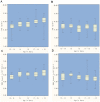Population-based biochemistry, immunologic and hematological reference values for adolescents and young adults in a rural population in Western Kenya
- PMID: 21713038
- PMCID: PMC3119664
- DOI: 10.1371/journal.pone.0021040
Population-based biochemistry, immunologic and hematological reference values for adolescents and young adults in a rural population in Western Kenya
Abstract
Background: There is need for locally-derived age-specific clinical laboratory reference ranges of healthy Africans in sub-Saharan Africa. Reference values from North American and European populations are being used for African subjects despite previous studies showing significant differences. Our aim was to establish clinical laboratory reference values for African adolescents and young adults that can be used in clinical trials and for patient management.
Methods and findings: A panel of 298, HIV-seronegative individuals aged 13-34 years was randomly selected from participants in two population-based cross-sectional surveys assessing HIV prevalence and other sexually transmitted infections in western Kenya. The adolescent (<18 years)-to-adults (≥ 18 years) ratio and the male-to-female ratio was 1∶1. Median and 95% reference ranges were calculated for immunohematological and biochemistry values. Compared with U.S-derived reference ranges, we detected lower hemoglobin (HB), hematocrit (HCT), red blood cells (RBC), mean corpuscular volume (MCV), neutrophil, glucose, and blood urea nitrogen values but elevated eosinophil and total bilirubin values. Significant gender variation was observed in hematological parameters in addition to T-bilirubin and creatinine indices in all age groups, AST in the younger and neutrophil, platelet and CD4 indices among the older age group. Age variation was also observed, mainly in hematological parameters among males. Applying U.S. NIH Division of AIDS (DAIDS) toxicity grading to our results, 40% of otherwise healthy study participants were classified as having an abnormal laboratory parameter (grade 1-4) which would exclude them from participating in clinical trials.
Conclusion: Hematological and biochemistry reference values from African population differ from those derived from a North American population, showing the need to develop region-specific reference values. Our data also show variations in hematological indices between adolescent and adult males which should be considered when developing reference ranges. This study provides the first locally-derived clinical laboratory reference ranges for adolescents and young adults in western Kenya.
Conflict of interest statement
Figures
Similar articles
-
Evaluation of locally established reference intervals for hematology and biochemistry parameters in Western Kenya.PLoS One. 2015 Apr 13;10(4):e0123140. doi: 10.1371/journal.pone.0123140. eCollection 2015. PLoS One. 2015. PMID: 25874714 Free PMC article.
-
Clinical laboratory hematology reference values among infants aged 1month to 17 months in Kombewa Sub-County, Kisumu: A cross sectional study of rural population in Western Kenya.PLoS One. 2021 Mar 17;16(3):e0244786. doi: 10.1371/journal.pone.0244786. eCollection 2021. PLoS One. 2021. PMID: 33730016 Free PMC article. Clinical Trial.
-
Reference values for clinical laboratory parameters in young adults in Maputo, Mozambique.PLoS One. 2014 May 14;9(5):e97391. doi: 10.1371/journal.pone.0097391. eCollection 2014. PLoS One. 2014. PMID: 24827458 Free PMC article.
-
Hematological parameters' reference intervals in apparently healthy individuals in Saudi Arabia: a systematic review and meta-analysis.Front Med (Lausanne). 2025 Apr 17;12:1522492. doi: 10.3389/fmed.2025.1522492. eCollection 2025. Front Med (Lausanne). 2025. PMID: 40313540 Free PMC article.
-
[Reference values for hematologic laboratory tests and hematologic disorders in the aged].Rinsho Byori. 2000 Mar;48(3):207-16. Rinsho Byori. 2000. PMID: 10804827 Review. Japanese.
Cited by
-
Evaluation of locally established reference intervals for hematology and biochemistry parameters in Western Kenya.PLoS One. 2015 Apr 13;10(4):e0123140. doi: 10.1371/journal.pone.0123140. eCollection 2015. PLoS One. 2015. PMID: 25874714 Free PMC article.
-
Establishment of the hematology reference intervals in a healthy population of adults in the Northwest of Morocco (Tangier-Tetouan region).Pan Afr Med J. 2018 Mar 23;29:169. doi: 10.11604/pamj.2018.29.169.13042. eCollection 2018. Pan Afr Med J. 2018. PMID: 30050633 Free PMC article.
-
Establishment of hematological reference intervals for healthy adults in Asmara.BMC Res Notes. 2018 Jan 22;11(1):55. doi: 10.1186/s13104-018-3142-y. BMC Res Notes. 2018. PMID: 29357920 Free PMC article.
-
Blood neutrophil counts in HIV-infected patients with cryptococcal meningitis: Association with mortality.PLoS One. 2018 Dec 31;13(12):e0209337. doi: 10.1371/journal.pone.0209337. eCollection 2018. PLoS One. 2018. PMID: 30596708 Free PMC article. Clinical Trial.
-
Community based hematological reference intervals among apparently healthy adolescents aged 12-17 years in Mekelle city, Tigrai, northern Ethiopia: A cross sectional study.PLoS One. 2020 Sep 14;15(9):e0234106. doi: 10.1371/journal.pone.0234106. eCollection 2020. PLoS One. 2020. PMID: 32925920 Free PMC article.
References
-
- Esparza J, Osmanov S. HIV vaccines: a global perspective. Curr Mol Med. 2003;3:183–193. - PubMed
-
- Jaoko W, Nakwagala FN, Anzala O, Manyonyi GO, Birungi J, et al. Safety and immunogenicity of recombinant low-dosage HIV-1 A vaccine candidates vectored by plasmid pTHr DNA or modified vaccinia virus Ankara (MVA) in humans in East Africa. Vaccine. 2008;26:2788–2795. - PubMed
-
- UNAIDS AIDS Epidemic Update Geneva, Switzerland, WHO press. 2008. UNAIDS. In press.
-
- WHO. Global tuberculosis control: surveillance, planning, financing. Geneva, Switzerland: WHO press; 2008.
Publication types
MeSH terms
Grants and funding
LinkOut - more resources
Full Text Sources
Medical
Research Materials


